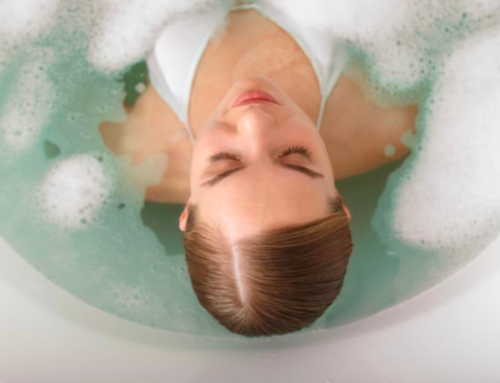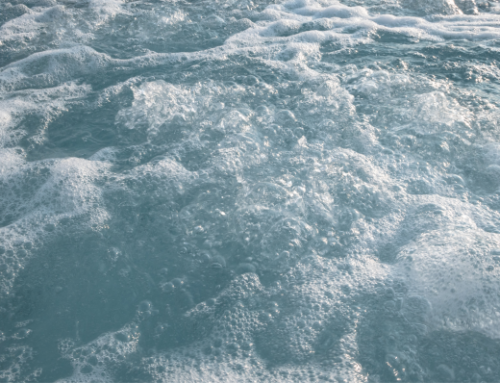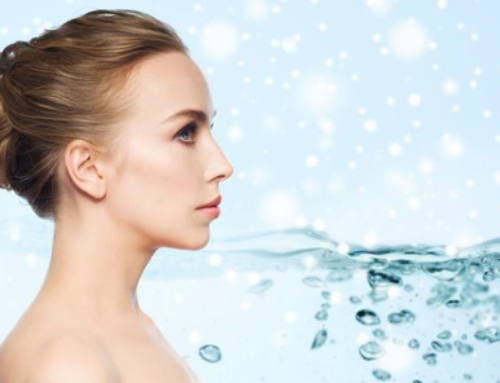Everyone is likely to experience back pain at some point in their lives—whether in the neck, shoulders, mid, or lower back. Unfortunately, these aches can be debilitating, and over time, can reduce your quality of life.
Hydrotherapy baths in the privacy of your home can provide pain relief as an alternative or in addition to pain medications, with fewer side effects. Laying in a tub may not seem like a treatment, but in this guide, we’ll show you how it can improve conditions that cause you back pain.
About Hydrotherapy
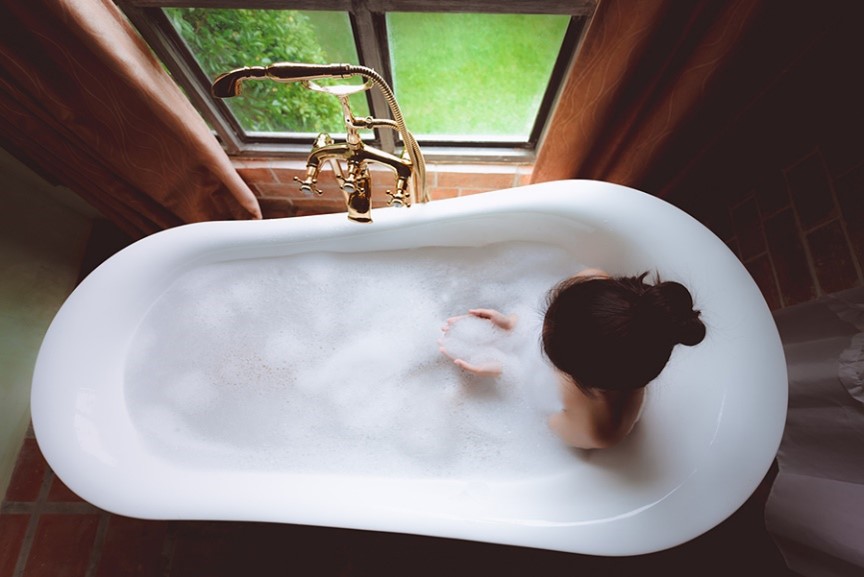
Bathing in warm water melts stress away, but it can also halt back pain, turning your soak into a relaxing, therapeutic self-care session.
Using warm or hot water as a natural treatment for physical ailments is called hydrotherapy. The practice has been used for thousands of years to help both physical and mental conditions.
There are different types of hydrotherapy, including taking a warm bath, taking a bath with massage jets, or doing stretching or gentle exercises in a pool. This guide mainly focuses on hydrotherapy heat and massage—massage techniques applied by water pressure. Combined with heat, these sensations are known to help arthritis, fibromyalgia, and general back pain problems.
You can receive hydrotherapy at home on-demand with your choice of a specialized whirlpool bathtub. Hydrotherapy tubs differ from regular bathtubs because they use water jets, air jets, and water circulation fittings to deliver warmth, comfort, massage, and pain relief.
About Back Pain
One of the most common reasons for visiting the doctor is back pain. According to the American Chiropractic Association, 50% of working Americans report back pain symptoms each year. Experts estimate that 80% of us will experience it at some point in our lives.
Although some people experience short-term pain, such as from an acute injury, back pain can last long-term, with aches coming and going for years.
In addition to helpful lifestyle habits like staying active and maintaining proper posture, many people rely on additional safe and natural treatments like a hydrotherapy program for back pain.
 Back Pain Symptoms
Back Pain Symptoms
You may feel back pain in the neck, shoulders, mid-back, low-back, and even radiating into your legs. The signs you experience depend on their cause.
In general, back pain signs and symptoms include pain described as:
- Shooting
- Burning
- Stabbing
- Throbbing
- Aching
You may also relate to feelings like:
- Difficulty standing straight without pain
- Shorter range of motion
- Reduced mobility
- Pain extending down your leg that gets worse when you bend, stand or walk
These sensations can be dull or severe. They may also subside and intensify over a period of time or depending on physical activity. Back pain is considered chronic when it lasts more than three months.
Back Pain Causes
Short-term back pain could be caused by a day of poor posture, which is common among people who work at a desk or stand for long periods. However, many times back pain suggests a more serious problem, linked to or caused by:
- Arthritis: Back pain, typically in lower areas, may be caused by spinal arthritis. These conditions are classified as spondyloarthropathies and include ankylosing spondylitis, psoriatic, reactive, and enteropathic arthritis. Other forms of the condition, like osteoarthritis, can also cause pain. Broken down cartilage in the spine can affect areas where the vertebrae join, resulting in irritation and more damage when you move.
- Injury: The most common causes of back pain are injuries you get from exercise, work, or home projects. If you don’t use the muscle often, you may overdo it and sprain it. Minor injuries like short falls, tripping, and twisting can also lead to aches. On the more serious end, herniated disc injuries may be caused or worsened by car crashes or big falls.
- Overuse: Many people can’t point to a specific cause of their pain but recall it building gradually. Musculoskeletal disorders (MSD), often called repetitive strain injuries, happen when soft tissue injuries develop over weeks or years. Exercising, lifting, standing, walking, and sitting are normal activities but can result in aches over time if you don’t have proper form or good posture.
- Skeletal disorders: Back pain could also be a sign of a skeletal disorder, such as scoliosis, degenerative disc disease, or spinal stenosis. For example, scoliosis can stretch or irritate the curve of your spine, causing aches. It may also strain joints and put pressure on spinal discs.
- Back surgery recovery: If you’ve had back surgery, you can expect some pain as you recover. Although you may ache for a few weeks, it can take at least three months and up to a year for your bones to heal.
Benefits of Hot Tub and Hydrotherapy for Back Pain Relief
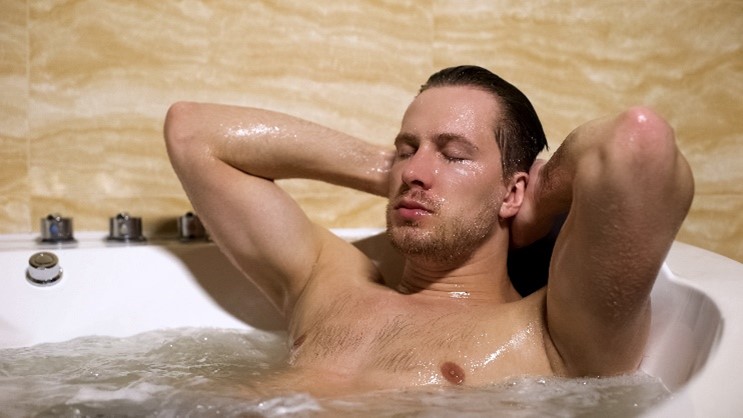
Using hydrotherapy for back pain is a good treatment option because it helps relax sore muscles, soothes aches, and improves flexibility and range of motion.
Hot tub therapy for lower back pain can also target painful muscle knots. The whirlpool jets work on contracted muscles, gently breaking them down, while the warm water comforts your aches. A jetted bathtub with targeted jet placement can directly hit problem areas effectively.
Hydrotherapy benefits the healing process too. Since the heat boosts circulation, the injured area can get nutrients easier, allowing you to recover sooner.
Water therapies have been used since ancient times, but science is catching up on how it can improve back pain. The following are the top health benefits of hydrotherapy for back pain relief.
Targets Neuromuscular Trigger Points
Many people wonder whether hydrotherapy is good for back pain and if it can really provide relief. According to myofascial trigger point therapists, one of the main reasons hydrotherapy helps is because water and air jets target neuromuscular trigger points, more commonly known as “muscle knots.”
Muscle knots are localized areas throughout the back that:
- Cause dull or sharp aches
- Are sensitive to pressure
- Feel hard or lumpy
Neuromuscular trigger points form after repetitive strain or a muscle injury and are a common source of back pain.
Despite being called a “knot,” these points are believed to be an area of tight, contracted muscle. This cuts off blood supply to the area, which causes more irritation. Trigger points can also create “referred pain,” meaning they can send pain to other parts of the body.
Trigger points require a therapeutic approach to unlock the contracted muscle. This is typically done by applying pressure until the muscle softens. One example is a trained massage therapist using myofascial release techniques. However, you can also get this benefit at home with a hydrotherapy tub as the water jets massage trigger points causing your pain.
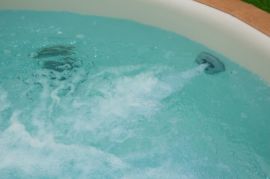 The water jets in back pain relief products are designed to target specific problems. Trigger points are most likely to develop in the neck, shoulders, and back area. Zone therapy also allows hydrotherapy jets to target the feet, another part where painful knots can form.
The water jets in back pain relief products are designed to target specific problems. Trigger points are most likely to develop in the neck, shoulders, and back area. Zone therapy also allows hydrotherapy jets to target the feet, another part where painful knots can form.
Another benefit is that the powerful, circulating jets can act similarly to a reflexology practitioner. Reflexology involves applying pressure to specific points on the hands or feet. These points are believed to be connected to other parts of the body, like organs. This may help to reduce pain and improve general well-being.
Boosts Circulation and Nourishment to Tissues
When seeking low back pain relief, people often recommend applying heat to the area. Heat dilates blood vessels, boosting blood flow to the area. It also allows oxygen and nutrients to flow more easily to the painful joints, muscles, and tissues.
A 2016 study showed that heat therapy can increase circulation and may reduce blood pressure. That may be helpful since back pain can stimulate the sympathetic nervous system and adrenal glands, increasing blood pressure.
Another advantage is that heat increases cell metabolism. This, combined with the transfer of nutrients and oxygen, helps the area to recover, reducing aches. In this way, a hydrotherapy hot tub or bath can encourage your body to self-heal.
While anyone searching for low back pain treatment may benefit from a hot hydrotherapy bath, it’s especially important after an injury or surgery. When your body is trying to repair, the circulation boost may speed up the process, getting you back to daily activities sooner.
Alleviates Pain Naturally
Hot baths are known to soothe achy muscles. But what’s so special about temperature? Heat triggers the release of endorphins, chemicals that play a role in how we feel.
 Endorphins act as a painkiller, minimizing how intensely we perceive pain. When endorphins are released, it triggers a set of reactions that stop the release of pain-inducing proteins.
Endorphins act as a painkiller, minimizing how intensely we perceive pain. When endorphins are released, it triggers a set of reactions that stop the release of pain-inducing proteins.
Interestingly, endorphins behave the same way in the brain as morphine does—the pharmacological painkiller. With endorphin activation, you may ease your pain while bypassing the side effects or risks of some drugs, like addiction. The relief benefits of hydrotherapy may also lead you to use less nonsteroidal anti-inflammatory drugs (NSAIDs), which can lead to serious conditions when used long-term.
Endorphins are also commonly called your body’s “feel-good hormones.” That means they can also help alleviate difficult emotions like stress, anxiety, and depression. While that can help you relax, it’s also an important benefit for those suffering from pain.
Physical pain is often accompanied by negative thoughts, leading to negative emotions. Those suffering from chronic aches who haven’t yet found lower back pain relief are at risk of developing clinical depression. Researchers say that pain and depression are connected by their brain regions and neurological systems. Because of this, some back pain patients may require antidepressants.
Since hydrotherapy for lower back pain can increase endorphins, it may have antidepressant-like benefits, helping you to feel better about your condition.
Relaxes Tense Muscles
After a stressful day at work or a rigorous workout, your muscles are tense, so you may relax in a warm tub. Everyone knows baths can send you into a relaxed mental state, but why does it work for your muscles too?
Muscle rigidity, also called stiffness or tension, is a main cause of muscle pain. Tightness won’t allow your muscles to relax as they normally would. Typically, when you need to use a muscle, your brain sends a signal to make it contract and tighten, letting it relax when its job is done. Stiffness happens when the muscle remains fully or partly contracted for a long period. You’ll notice the longer you feel tense, the more painful it becomes.
Hydrotherapy for low back pain works because the heated water dilates blood vessels, increasing blood flow. Improved circulation allows tight muscles to relax and stop contracting, alleviating the soreness. When they’ve softened, they’ll be easier to stretch out, further reducing stiffness. This is why your doctor may recommend heat packs or a hydrotherapy whirlpool tub for lower back pain treatment at home.
Relieves Inflammation From Strained Muscles and Tissues
Hydrotherapy benefits include reduced inflammation of muscles and tissues. Inflammation in your back doesn’t always result from arthritis or health conditions. Anyone can experience acute inflammation as an immune reaction to a physical trigger. For example, an injury you get while playing sports or working can inflame your back. It can also result from excessive strain, like repeated heavy lifting.
When your body realizes there’s damage present, your immune system works to protect you. One way it does this is by collecting plasma proteins in the tissues, causing a buildup of fluid. Hydrotherapy for chronic low back pain can help reduce the amount of fluid.
In one study, researchers asked volunteers to sit in a bath for one hour. They had ten baths over two weeks. Each session, researchers tested their blood three times:
- Before getting into the bath
- Immediately after the bath
- Two hours later
They found that after only one immersion, participants’ nitric oxide (NO) production increased. NO is believed to have anti-inflammatory properties. Over the two-week therapy course, participants had an initial increase in inflammation, but that was followed by a long-term decrease. The authors concluded that immersing in hot water may improve the inflammatory profile of sedentary, overweight men.
When spending extended periods of time in a hydromassage whirlpool bathtub, it is helpful to choose a jetted bathtub with specially designed comfort features so your body can relax while controlling temperature and providing relaxing jet streams.
Relieves Pressure From Compressed Joints
When you get into a hydrotherapy hot tub, you immediately feel weightless. This is another reason why you can use a hot tub for back pain—it cradles your body in a neutral position, taking pressure off your spine. Some people report that it can cut the weight your body bears by up to 90%.
The buoyancy of water acts against the force of gravity, releasing any weight on your joints, bones, and muscles. This allows you to move easier and with less pain. It may also work to release pinched nerves and decompress spinal discs. The warmth of the water can also play a role in taking the burden off of joints, promoting muscle relaxation.
Researchers say the pressure of water in hydrotherapy can promote thermal sensation while blocking the brain’s pain receptors. This can have a positive effect on the spinal cord, aiding in upper and lower back pain relief.
Improves Spinal Mobility and Flexibility
Hydrotherapy for chronic back pain can also improve your ability to move your back. If stretching the wrong way or reaching for something leads to aches, floating can improve your back flexibility too. The weightless feeling you get while submerged in water releases pressure from your joints and muscles. This gives you the ability to stretch and move in ways that may be normally painful on land.
One study investigated whether hydrotherapy could improve lumbar spondylosis, a type of lower back pain. Twenty people were given three weekly sessions for four weeks. Researchers assessed their condition before, after, and three months later. Results showed that thoracic-lumbar mobility improved, and researchers noted that hydrotherapy treatment should be ongoing for best results.
Although some people gain better back mobility by going to a hydrotherapy spa, you can get similar back pain relief at home. Having a hydrotherapy jetted whirlpool tub at home means you can do back stretches at your convenience and comfort on an ongoing basis.
Back Pain Relief at Home

Back pain treatment at home is possible using a hydrotherapy bathtub. You can allow your muscles to soften anytime they begin to ache, whether that’s a couple of times a day or once a week. While the warm jets can act as lower back pain treatment, they can also improve your quality of life in general by promoting mental relaxation.
Although hydrotherapy can help many conditions, you should avoid heat for a few days following an acute injury or arthritis flare. Hydrotherapy side effects are relatively rare and stem from overheating or reactions to heat.
There are multiple options available for receiving hydrotherapy at home. For example, a Soothing Soak bathtub gently circulates warm water to relieve sore muscles. This also boosts circulation and promotes healing. Other options include heated jetted whirlpool bathtubs that use jets to massage out knots, leaving you with better flexibility and range of motion.
Sources:
- https://www.lib.uwo.ca/archives/virtualexhibits/londonasylum/hydrotherapy.html
- https://www.spineuniverse.com/treatments/pain-management/back-pain-spas-hydrotherapy-pilates-yoga
- https://www.mayoclinic.org/diseases-conditions/back-pain/symptoms-causes/syc-20369906
- https://www.acatoday.org/Patients/What-is-Chiropractic/Back-Pain-Facts-and-Statistics
- https://www.ninds.nih.gov/Disorders/Patient-Caregiver-Education/Fact-Sheets/Low-Back-Pain-Fact-Sheet
- https://www.arthritis.org/health-wellness/about-arthritis/where-it-hurts/when-back-pain-may-mean-arthritis
- https://www.healthlinkbc.ca/health-topics/bacpn
- https://osg.ca/how-to-prevent-msd/
- https://www.healthline.com/health/scoliosis-pain
- https://medlineplus.gov/ency/patientinstructions/000313.htm
- https://www.painscience.com/tutorials/trigger-points.php
- https://namtpt.wildapricot.org/MTPT_What_is_it
- https://www.healthline.com/health/what-is-reflexology#benefits
- https://www.fleetfeet.com/s/hartford/sports-medicine/ice-vs-heat
- https://www.healthline.com/health-news/cant-work-out-try-a-hot-bath#Exercise,-hot-water,-and-health
- https://www.ncbi.nlm.nih.gov/pmc/articles/PMC5023696/
- https://spineina.com/blog/back-pain-can-impact-blood-pressure/
- https://www.webmd.com/depression/guide/exercise-depression#1
- https://www.ncbi.nlm.nih.gov/pmc/articles/PMC4049052/
- https://www.ncbi.nlm.nih.gov/pmc/articles/PMC3104618/
- https://www.ncbi.nlm.nih.gov/pmc/articles/PMC3158445
- https://www.ncbi.nlm.nih.gov/pmc/articles/PMC5494581/
- https://www.healthline.com/health/muscle-rigidity
- https://www.livestrong.com/article/436307-baths-for-muscle-aches-and-soreness/
- https://www.spineuniverse.com/wellness/tips-hot-baths-relax-back
- https://www.medicalnewstoday.com/articles/248423
- https://www.medicalnewstoday.com/articles/323702
- https://journals.physiology.org/doi/full/10.1152/japplphysiol.00407.2018
- https://www.spine.org/KnowYourBack/Treatments/Nonsurgical-Treatments/Hydrotherapy
- https://sportandspinalphysio.com.au/swimming-hydrotherapy-keeping-fit-injury/
- https://www.ncbi.nlm.nih.gov/pmc/articles/PMC4049052/
- https://www.sciencedirect.com/science/article/pii/S0004951414605432
- https://www.researchgate.net/publication/273933741_Hydrotherapy_versus_land-based_exercises_in_the_management_of_chronic_low_back_pain_A_comparative_study
- https://www.spasunlimited.com/7-hot-tub-stretches-lower-back-pain/
- https://www.healthlinkbc.ca/healthlinkbc-files/hot-tub-pool-safety
- https://www.mayoclinic.org/healthy-lifestyle/pregnancy-week-by-week/expert-answers/pregnancy-and-hot-tubs/faq-20057844

